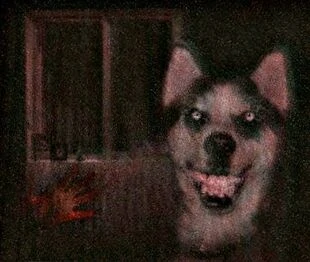Get ready to shiver and prepare yourself for the horrors the internet can deliver: it’s time to dive into the paranormal world of Creepypastas. Horror stories such as that of Count Dracula,werewolves, vampires, or ghosts have long roots in past societies and are widely known. Yet, an among young thrill-seekers even more famous monster like Slender Man isn’t based on ancient folklore situated around Transylvanian castles. It’s a creation from contemporary forum-using, anonymous Dr. Frankensteins. Created and improved on the web, these Creepypastas – a term derived from Copypastas, coming from the process of copying and pasting content online – are constantly evolving and gain their agency by user-engagement, making them uncontrollable monsters. But what makes these Creepypastas different from and often more terrifying than traditional horror stories? And how has Slender Man become such a vivid nightmare in such a short time? You’re on the threshold of an endless virtual haunted house. Let’s step inside!
Creepypastas are messages meant to be shared on the web like a chain-letter, that claim to reveal a certain paranormal or terrifying hidden truth about some entity, people, or the world in general. Because they present us with unconventional narratives that differ from most people’s world view, they rely on a strong rhetoric and often imitate detailed personal stories or news items, to come across as authentic. These Creepypastas make frequent use of supposed curses, which could come over you when you don’t interact with them in the way it asks of you. An example of this is the creepypasta smile.dog, a scary manipulated image of a dog which threatens to visit your dreams if you do not share the image with others. Apart from the stories emerging on the internet of people affirming the curse of smile.dog coming over them, the Creepypasta’s contributors deny deviating narratives by claiming there to surface a lot of non-paranormal copies of the cursed image. The chaining of these images is the cure to their supposed curse. By engaging in their rituals, one appoints the images a certain agency, which makes the stories more credible for potential future viewers because of the abundance of people engaging with them in the way they are told to.1

These creepypastas play into several human instincts to spread. They are initiated by triggering one’s curiosity, then creep users out by instigating a cognitive dissonance and at last play into people’s superstition or social nature, to reach other users. People’s curiosity is stimulated by the process of their network recycling the Creepypasta on their feed, after which they often click on it to see what the fuzz is all about, following them diving into the horrors it presents. Then, when one is thoroughly scared, a cognitive dissonance hits them: on the one hand, the stories are too bizarre to be true; haunting pictures? Monsters coming closer when you look behind you? That is not part of our logical perception of the world. Yet, you still feel frightened and thus are in conflict, which gives a thrill of fear, although you rationally know it’s not real… or is it? The superstitious nature kicks in. The Creepypastas are so heavily backed up online, that you might start to consider their authenticity. This could lead to you making a risk assessment; although chances are small this monster is real, you just want to make sure you’re safe. Or, if the story has been very emotionally heavy to read, you might want to share it with others to spark their curiosity or simply pour out your heart. And there you go, sending the now agency-possessing Creepypasta to future fellow sufferers.
Of course, this is not different from how old horror stories based on oral or textual tradition work. Yet, the contemporary virtual setting of these stories gives it a new dimension. You can’t divide yourself and your fears from them by time and place. These horror stories about paranormal happenings or creatures are so new that they can’t be put away as ancient myths. Some contemporary people, who are like you users of the internet, are scared out of their minds by them. The anonymity of these people doesn’t make it easier as well: although some reports are site specific, a whole bunch of anonymous people (possibly even your neighbor) engage with them or confirm their existence, giving the stories and their depicted monsters boogieman-ish ambiguous natures. They could be anywhere. Specifically the Slender Man story has become so famous because of its multi-media appearances and this ambivalent nature. The open-source story stems from the internet-forum Something Awful, when in 2009 user Victor Surge uploaded a picture of children running from a tall, slender, faceless figure, after which 14 children had reportedly gone missing.

This sparked a wave of people confirming the Slender Man’s existence by even writing historic narratives in the form of ‘old news articles’ or medieval prints. The more was contributed, the larger this snowball of horror grew and the stronger its story became as only the convincing ‘evidence’ was upvoted and recycled, leading to a 21st century, digitally born boogieman story. By the emerging of vast amounts and shapes of additions to this story (even games and films were made), it had, and still has, an incredible reach. This virality gives it its non-site-specificity, making every forest frightening at night after having engaged with the story. Slender Man plays into primal fears by supposedly coming closer when you look behind you, resembling the ancient myth of Orpheus and Eurydice.2

Although the virtuality of Creepypastas makes their roots more traceable and by that possibly less mythical or magical, they tap into several human instincts to instill fear and spread their contagious curse, making use of the natural selection of the internet to improve their story. Their collective nature gives them a great relatability, as all kinds of people affirm the Creepypastas‘ agencies and new internet folklore is created. Slender Man is a perfect example to this, as the story has been so widespread and deepened by supposed evidence that its image has become unescapable. The digital network around it has created its paranormal powers, which it didn’t have before… Or did it?
1 Line Henriksen, “‘Spread the Word’: Creepypasta, Hauntology, and an Ethics of the Curse,” University of Toronto Quarterly 87, no. 1 (2018): pp. 266-280, https://doi.org/10.3138/utq.87.1.266.
2 Shira Chess, “Open-Sourcing Horror,” Information, Communication & Society 15, no. 3 (2012): pp. 374-393, https://doi.org/10.1080/1369118x.2011.642889.


An interesting read! I was really into creepypasta’s when I was younger and used to be just terrified of that smile. dog picture. I think what helps give these stories on the internet some validity is that especially on forums, is that people for the most part can stay anonymous. Which makes it much harder to fact check them, compared to your friend telling you a scary ghost story.